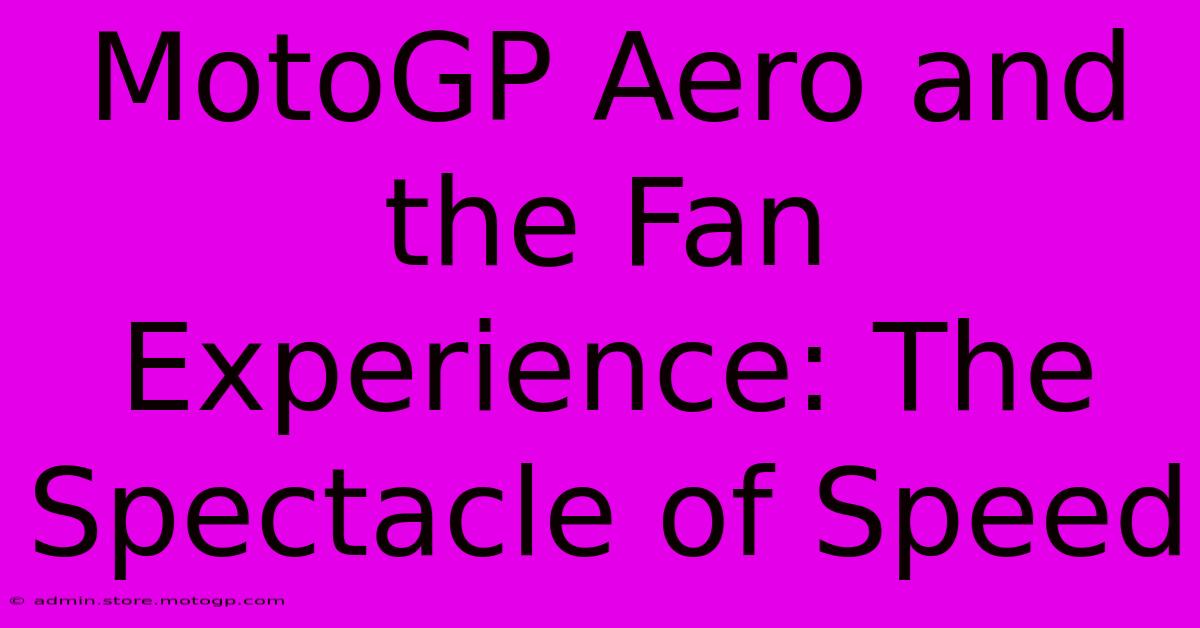MotoGP Aero And The Fan Experience: The Spectacle Of Speed

Table of Contents
MotoGP Aero and the Fan Experience: The Spectacle of Speed
MotoGP. The very name conjures images of screaming engines, breathtaking speeds, and the sheer artistry of world-class riders pushing machines to their absolute limits. But what truly elevates the MotoGP experience beyond the raw power is the intricate interplay of technology and spectacle, most notably the increasingly sophisticated aerodynamics shaping the race. This article delves into the fascinating world of MotoGP aero, exploring its impact on the racing itself and how it enhances the fan experience.
The Science of Speed: Understanding MotoGP Aerodynamics
MotoGP bikes aren't just fast; they're aerodynamically sculpted masterpieces. Every curve, every winglet, every carefully positioned duct is designed to maximize downforce and minimize drag. Aerodynamic performance is paramount; it dictates cornering speeds, stability at high velocity, and ultimately, the race outcome.
Downforce: The Grip Factor
Downforce, the force pressing the bike towards the track, is crucial for MotoGP. Increased downforce translates directly into increased cornering speed and stability. Think of it as an invisible hand holding the bike to the asphalt, allowing riders to lean further and maintain higher speeds through bends. This is achieved through a variety of aerodynamic devices, including:
- Aerodynamic wings: These are the most visible components, generating significant downforce. Their design constantly evolves, with teams experimenting with different shapes and sizes to optimize performance for specific tracks.
- Fairings and bodywork: The entire design of the bike's body is optimized for airflow, directing air around the rider and minimizing drag. Even small changes to the fairing can significantly affect overall performance.
- Underbody aerodynamics: The underside of the bike is just as crucial as the top. Clever airflow management beneath the bike contributes significantly to downforce and stability.
Drag Reduction: The Race for Efficiency
While downforce is vital, minimizing drag is equally important. Drag is the resistance a bike faces as it moves through the air. Reducing drag allows for higher top speeds on straights and better fuel efficiency. This is achieved through:
- Streamlined bodywork: The shape of the fairing is designed to reduce air resistance. This is a delicate balance; a more streamlined shape might reduce downforce.
- Careful placement of components: Even small components, if not positioned correctly, can increase drag.
The Fan's Perspective: A Spectacle Enhanced by Aero
The impact of MotoGP aero isn't confined to the track; it significantly impacts the fan experience. The advancements in aerodynamics are not only crucial for close racing but also provide a visual spectacle that captivates audiences:
The Thrill of Close Racing:
The sophisticated aero packages allow riders to push harder through corners, leading to closer racing and more overtaking opportunities. This translates to more exciting races, which are more gripping for viewers.
The Visual Spectacle:
Modern MotoGP bikes, with their intricate wings and sculpted bodywork, are visually striking. The aerodynamic components add a futuristic aesthetic that complements the raw power and speed of the machines. The intricate details provide a fascinating visual element for viewers who appreciate the engineering and technology involved.
Understanding the Technology:
For many fans, understanding the technical aspects of the sport enhances the viewing experience. Learning about downforce, drag, and the role of aerodynamics adds a layer of depth and appreciation. This understanding can be fostered through educational content and broadcast commentary.
The Future of MotoGP Aero: Continuous Evolution
The evolution of MotoGP aerodynamics is a continuous process. Teams are constantly innovating, pushing the boundaries of what's possible. The future likely holds even more sophisticated aerodynamic solutions, leading to even faster, more exciting races, and a further enhanced viewing experience for fans around the globe. Expect to see continued developments in:
- Active aerodynamics: Systems that dynamically adjust the bike's aero components based on track conditions and rider input.
- Computational Fluid Dynamics (CFD): Increased use of CFD simulation to optimize designs and minimize testing time.
- Lightweight materials: The search for lighter materials to reduce weight without compromising aerodynamic performance.
In conclusion, MotoGP aerodynamics is a crucial element that shapes not only the racing itself but also the overall fan experience. It's a captivating blend of science, technology, and spectacle, making MotoGP a truly unique and thrilling motorsport. The continuous evolution of aerodynamic technologies promises even more exciting races and visually stunning bikes in the years to come.

Thank you for visiting our website wich cover about MotoGP Aero And The Fan Experience: The Spectacle Of Speed. We hope the information provided has been useful to you. Feel free to contact us if you have any questions or need further assistance. See you next time and dont miss to bookmark.
Featured Posts
-
Analyzing The F1 Starting Grid For Race Day Success
Feb 20, 2025
-
V 4 Yamaha The Heart Of Innovation
Feb 20, 2025
-
Us Grand Prix Sprint Time The Road To Victory
Feb 20, 2025
-
F1 Grid Strategies How Teams Utilize Grid Formula 1
Feb 20, 2025
-
F1 Parking Pass Your Pass To The Best Parking
Feb 20, 2025
